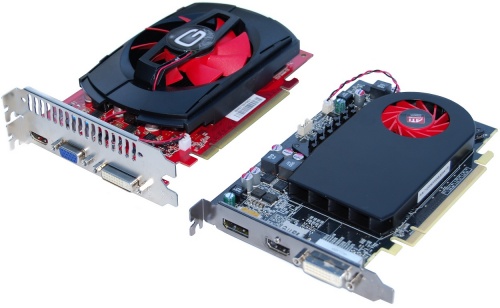Radeon HD 5670 in Detail
The Radeon HD 5670 is the first board in the HD 5000 series to use a single slot design, making it a solid choice for HTPC systems. The card is said to consume just 61 watts of power under load, which is considerably less than the 108 watts of the Radeon HD 5770, or the 188 watts of the Radeon HD 5870.


As a result the Radeon HD 5670 should generate little noise and likely overclock very well, assuming the single slot cooler can keep it running at a reasonable temperature – we'll look into that shortly.

Compared to the Radeon HD 5770, which measures 21cm, the Radeon HD 5670 is just 17cm long. This is the same as the GeForce GT 240 and therefore should fit in any case that can support a mATX motherboard.
The core configuration of the Radeon HD 5670 includes 400 SPUs, 20 TAUs (Texture Address Units) and 8 ROPs (Rasterization Operator Units). That's exactly half as many SPUs, TAUs and ROPs as the Radeon HD 5770, and the same as the older Radeon HD 4670.
Core clock speed is set at a respectable 775 MHz, with more than 600 TeraFLOPS of raw computing power, while GDDR5 memory operates at 1000MHz. The Radeon HD 5670 can come configured with either 512MB or 1GB of memory – the sample we are reviewing today features just 512MB.

Cooling the "Redwood XT" GPU (name designated to the budget version of Evergreen) is a fairly small aluminum heatsink made up of numerous fins measuring 4cm long, 6cm wide and 1cm tall. There is no copper base or heatpipe technology being used in this card, only a 45x10mm blower fan that sucks air from within the case and pushes it over the heatsink.
The Radeon HD 5670 features a remarkably low 14 watt idle consumption level, making it one of the most efficient graphics cards available today. When pushing the card to its limit it will still suck up 61 watts, and even with the increased thermal stress, noise levels were very good – comparable to those of the Radeon HD 5750 or GeForce GTS 240 graphics cards.

A big plus about the Radeon HD 5670 consuming so little power is that it doesn't require an external power source. Rather, the PCI Express bus alone is capable of delivering enough current to this card.
There are no bridge connectors on the Radeon HD 5670, but it's still possible to link two of these graphics cards through internal CrossFire. As mentioned before, the Radeon HD 5670 keeps Eyefinity support. Like its higher-end variants in the 5000 series, you can hook up to three high resolution monitors (up to 2560x1600) to this board. If not for gaming, it can still be a handy feature to have for the ultimate productivity workstation spanning three monitors.
